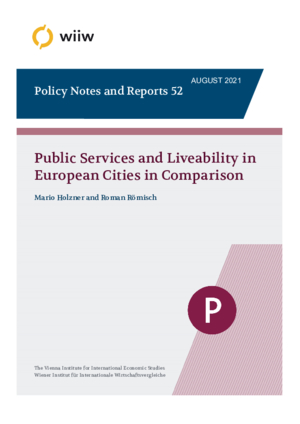Public Services and Liveability in European Cities in Comparison
Mario Holzner and Roman Römisch
wiiw Policy Note/Policy Report No. 52, August 2021
18 pages including 2 Tables and 6 Figures
A high level of public services in housing, transport, education and health care is essential for liveability in urban centres, as shown in this report, with the help of European data for large cities. Inhabitants of larger cities, where the housing market is heavily commercialised in terms of the share of homeownership, and where little social housing exists, have to save on consumption items that offer a higher quality of life, such as in Italy. On the opposite side, for instance, cities in Austria, the Netherlands, Sweden and France have housing markets that are much less commercialised and where a lot of social housing exists. These are exactly the urban centres that achieve the top rankings in our new Urban Public Services and Liveability Index (UPSLIde), with Austria in first place. Over time, UPSLIde trends downward, with the ratio of expenditure on the finer things in life relative to obligatory consumption items influenced by public services provision sliding from around 70% in the late 1980s to less than 50% in the 2010s. In order for this negative trend to be reversed, public services provision needs to be stepped up and, in particular, rising housing rental costs need to be countered by more social housing construction.
Keywords: Housing policy, transport policy, education policy, health policy, public services, urban well-being, index ranking, household expenditure, cities, Europe
JEL classification: C43, D12, E21, R38, R48, H44, H51, H52, H53, H54, H75, H76, I18, I28, I38
Countries covered: Austria, European Union
Research Areas: Regional Development
